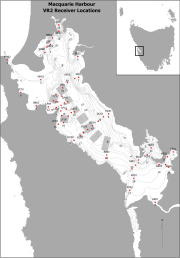ENVIRONMENTAL IMPACTS
Type of resources
Topics
Keywords
Contact for the resource
Provided by
Years
-

This record provides an overview of the NESP Marine and Coastal Hub scoping study - "Research needs for a national approach to socio-economic values of the marine environment". For specific data outputs from this project, please see child records associated with this metadata. -------------------- Effective management of the marine estate requires recognition of the fact that we live in a connected human-natural system. Human uses of the marine environment often create pressures that drive overall condition, but it is also these uses that create ‘benefits’ or ‘values’ in the marine environment. Thus understanding the coupled relationships between humans and nature is essential to managing the marine environment that delivers environmental, social and economic outcomes. In this project we will work with stakeholders (particularly DAWE) through co-design to identify: (a) social and economic research priorities, and (b) existing social and economic data sets to address these priorities. This project includes, as a key differentiation from previous NESP MHB projects, an additional theme on implementation and behaviour change that will ensure research can inform the full pathway from policy to on ground action. This work will set the research direction for projects under the NESP 2 MAC and involve co-designed project proposals. Outputs • Inventory of compiled datasets relating to relevant economic values, threats, and socioeconomic values for Case Study locations [grey data] • Final technical report with analysed data and a short summary of recommendations for policy makers of key findings [written]
-

This record provides an overview of the NESP Marine and Coastal Hub small-scale study - "Australia’s Coastal Shorebirds: Trends and Prospects". No data outputs were generated by this project. -------------------- Coastal Australia is home to 37 regularly occurring migratory shorebird species, with many protected areas including Ramsar sites designated on the basis of shorebird populations. Many migratory shorebirds are declining rapidly, and hence the focus of conservation efforts at multiple levels of government in Australia and overseas. However, trend data are now nearly 10 years old, meaning the information available to assess where conservation actions are needed most urgently and whether conservation efforts are helping species recover are outdated. To ensure populations have the best chance at recovery and that resources are allocated where they are most likely to have the greatest positive impacts, it is critical to maintain up-to-date information on species trends. This project analyses 30 years of shorebird monitoring data collected by citizen science groups across Australia and curated by BirdLife Australia’s National Shorebird Monitoring Program.to update national trend estimates, while also assessing the relative effects of human pressure and conservation efforts on population trends. This project will set the stage for building the next decade of coastal shorebird conservation activity in Australia, coordinated through the national mechanism of the End User: National Migratory Shorebird Conservation Action Plan Steering Committee, with representatives from national and state governments as well as leading shorebird experts. Outputs • Final technical report with analysed data and a short summary of recommendations for policy makers of key findings [written] ---no data outputs were generated by this project---
-

This record provides an overview of the NESP Marine and Coastal Hub small-scale study - "Microplastics in South Eastern Australian coastal waters: synthesising current data and identifying key knowledge gaps for the management of plastic pollution". For specific data outputs from this project, please see child records associated with this metadata. -------------------- Plastic pollution is pervasive in coastal environments globally and in Australia. Due to their small size, microplastics (pieces <5mm) are readily ingested by marine organisms and potentially accumulate across food webs, raising concerns for biota, ecosystem services and human health. Yet, to define guidelines and support policy actions that curb microplastic pollution, managers and decision-makers lack clear, synthesised information on this multifaceted issue, including on occurrence, sources, and pathways of microplastics in coastal and marine environments. This project produces a synthesis of current data on microplastics in South Eastern Australian coastal waters (i.e. South Australia, Victoria and New South Wales) and identify key knowledge gaps for the management of plastic pollution. Outputs • List of compiled datasets relating to microplastics in SE Aus waters [spatial dataset] • Scoping document synthesising the information available on the presence of microplastics in coastal marine environments in South Eastern Australia, its potential sources and pathways [written]
-

Fixed position oxygen and water temperature logger data from the Macquarie Harbour World Heritage Area (WHA). Two Hobo oxygen data loggers are positioned at approximately 15 m depth at different sites within the WHA, with the intent of monitoring representative mid-bottom water oxygen values in the WHA as these were identified in previous studies to be naturally low due to limited seawater exchange at the harbour entrance, and thus likely to be most susceptible to anthropogenic factors that may increase oxygen demand and alter WHA conservation values. These values include core habitat of the Maugean Skate, a listed threatened species. This work is funded by WHA advisory board via the Nature Conservation Branch of DPIPWE and is part of a larger study being conducted by IMAS undertaking a biological baseline study of the biodiversity of the Macquarie Harbour WHA. This data spans 08/11/14 to present (most recent update 02/02/17).
 IMAS Metadata Catalogue
IMAS Metadata Catalogue